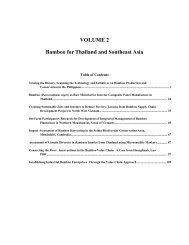WBC-VIII-Vol.4 – Resources – Forestry, Plantations and ... - BambuSC
WBC-VIII-Vol.4 – Resources – Forestry, Plantations and ... - BambuSC
WBC-VIII-Vol.4 – Resources – Forestry, Plantations and ... - BambuSC
Create successful ePaper yourself
Turn your PDF publications into a flip-book with our unique Google optimized e-Paper software.
of average forest tree st<strong>and</strong>s (100<strong>–</strong>160 t/ha), but does not match that of the very high values attained by some<br />
tree st<strong>and</strong>s (300<strong>–</strong>1,700 t/ha; Hunter <strong>and</strong> Wu 2002). In contrast to trees that can accumulate biomass over long<br />
periods through radial <strong>and</strong> vertical extension of stems (trunks), bamboo culms lay down most of their biomass<br />
within their first year of growth, largely from current assimilation but also from redistribution from older culms<br />
<strong>and</strong> rhizomes (Magel et al. 2006), <strong>and</strong> die off after a maximum of 8<strong>–</strong>10 years, resulting in a decline in biomass<br />
of individual culms over long periods. Isagi (1994) referred to this as the biomass accumulation ratio<br />
(biomass/net annual production) <strong>and</strong> showed it to be 4.66 for a st<strong>and</strong> of Phyllostachys bambusoides in Japan.<br />
Culms on average comprise c. 75-83% of total aboveground biomass, branches c. 12-15% <strong>and</strong> leaves c. 5-7%.<br />
On an annual basis, above-ground culm growth rates (fresh weight) of 10<strong>–</strong>30 t/ha/year have been reported<br />
(summarised by Kleinhenz <strong>and</strong> Midmore 2001), which is in line with those of woody species (Hunter <strong>and</strong> Wu<br />
2002). Although one report with Bambusa bambos mentions 47 t/ha/year, productivity of bamboo on an annual<br />
basis is generally no greater than that of woody species, <strong>and</strong> bamboo is no more efficient at sequestering carbon<br />
than are woody species. Below the ground, bamboo sequesters carbon in the form of rhizomes, <strong>and</strong> belowground<br />
biomass is greater proportionately for monopodial (running) species at c. 43% of total biomass compared<br />
to c. 31% for sympodial (clumping) species (Kleinhenz <strong>and</strong> Midmore 2001). The rhizome therefore represents<br />
an important sink for sequestered carbon but, according to Hunter <strong>and</strong> Wu (2002), this sink is no larger than that<br />
of woody trees. One advantage of bamboo over trees is that culms can be harvested much sooner than trunks of<br />
woody species (Figure 1) <strong>and</strong> another is that they can be harvested on an annual basis without the environmental<br />
consequences of clear-fell. Given that culms can be harvested on an annual basis, inter-culm competition for<br />
light is lessened, <strong>and</strong> younger culms, those with greater photosynthetic efficiency, gain greater access to light,<br />
supporting therefore faster growth rates. This is evident in Zhu et al. (2009) who show the drop in light<br />
interception by the canopy when older culms are harvested <strong>and</strong> the capture of that light by younger culms soon<br />
thereafter. The effect on biomass is marked. For example, net annual biomass production of 9.3 t/ha per year in<br />
12-15 year old Dendrocalamus asper was raised to 26.3 t/ha per year one year after culms >4 years of age were<br />
removed from the clumps (Kao <strong>and</strong> Chang, 1989).<br />
Removal of all culms at harvest represents removal of c. 150 kg N, 30 kg P <strong>and</strong> 260 kg K per hectare, leaving<br />
between 25 to 70% of those amounts in the rhizomes (Kleinhenz <strong>and</strong> Midmore 2001). Exceptionally, higher<br />
values up to five times these have been reported. On an annual basis, with culm yields of on average 13 t/ha/yr c<br />
36 kg N, 9 kg P <strong>and</strong> 63 kg K are removed per hectare, but with culm yields possibly four times these values<br />
much more would be removed.<br />
Leaf litter annually provides between 13-22% of the total NPK in total biomass, when st<strong>and</strong>s are 6 years or<br />
older, <strong>and</strong> some is taken up for incorporation into new leaves which are the major sinks for nutrients. The<br />
resorption efficiency is higher for K (c. 43%) less for P (37%) <strong>and</strong> least for N (19%) (Embaye et al. 2005).<br />
Internal recycling is important for bamboo to make efficient use of nutrients, as is the ability to take up nutrients<br />
from a decomposing litter mass (Das <strong>and</strong> Chaturvedi, 2006). Nevertheless, without nutrient inputs the soil<br />
nutrient resource declines, as illustrated by data of Wu et al. (2006) showing that total soil N decreased by 5.2%<br />
<strong>and</strong> available P by 15% following 3 years continuous cropping with Phyllostachys iridescens.<br />
<strong>VIII</strong> World Bamboo Congress Proceedings Vol 4-71




